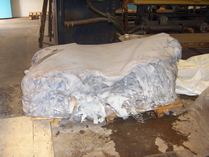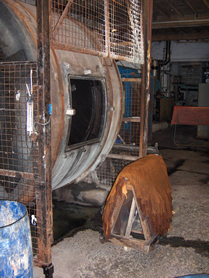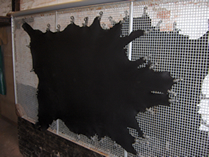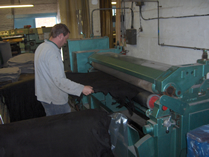ALC Deer Leather is made from the skins of farmed animals, reared for
commercial venison sales. The meat, from the DEFRA licensed abattoir
goes off to the restaurant kitchens of renowned chefs, hotels and premium
supermarket ranges and the skins are salted to preserve them for tanning.
The tanning process is fundamentally a chemical means of turning the
collagen protein in the skins, which is unstable and putescible, into
a material that is stable and will not rot. The nature of the specific
application of the process governs the properties of the resulting leather.
Tanning hides and skins to make leather has been around since pre-historic
times and the commercial methods applied today are scientifically well
understood and controlled.
STAGE 1 Tanning
 The
salted skins are taken to a commercial tannery, where the fundamental
preservation (tanning process) will take place. Over several days, using
large quantities of water (to remove and wash away unwanted protein
constituents –hair & fats, that prevent the tanning solution
getting full effect on the collagen protein of the skins) and carefully
measured amounts of chemicals, the skins are converted into the first
“rough-tanned” stage. Making light-weight leathers that
will be soft and flexible uses a quantity of Chromium Sulphate as the
main tanning agent. (Approximately 85% of the leather made in the world
is Chrome-tanned).
The
salted skins are taken to a commercial tannery, where the fundamental
preservation (tanning process) will take place. Over several days, using
large quantities of water (to remove and wash away unwanted protein
constituents –hair & fats, that prevent the tanning solution
getting full effect on the collagen protein of the skins) and carefully
measured amounts of chemicals, the skins are converted into the first
“rough-tanned” stage. Making light-weight leathers that
will be soft and flexible uses a quantity of Chromium Sulphate as the
main tanning agent. (Approximately 85% of the leather made in the world
is Chrome-tanned).
The Chrome imparts a blue colouration to the skins and the material
is referred to as “wet-blue” at this stage. The skins are
put through a samming machine, which is effectively an industrial mangle,
to remove excess water and reduce the weight for transport, then the
skins are taken to the next stage in the dressing plant.
STAGE 2 Dressing
 This
is the point at which the actual customer specifications for thickness,
colour and feel can be achieved. The skins are shaved on the flesh side
to achieve an accurate tolerance, giving the desired thickness, then
they go into the dyeing process, again over several days. In the dyeing
vessel, a 5-stage chemical process prepares the skins for dyeing, firstly
allows the dyes to be mixed, to match a specific colour requirement
and penetrate evenly through the thickness of the skin. Next a particular
blend of extra tanning agents (special proprietary chemicals) is used
to modify the ultimate feel of the leather, once dried. Specific types
are selected for a firmer-dress shoe or bag leather, and different ones
for clothing or glove leather, depending on the needs of the customer.
This
is the point at which the actual customer specifications for thickness,
colour and feel can be achieved. The skins are shaved on the flesh side
to achieve an accurate tolerance, giving the desired thickness, then
they go into the dyeing process, again over several days. In the dyeing
vessel, a 5-stage chemical process prepares the skins for dyeing, firstly
allows the dyes to be mixed, to match a specific colour requirement
and penetrate evenly through the thickness of the skin. Next a particular
blend of extra tanning agents (special proprietary chemicals) is used
to modify the ultimate feel of the leather, once dried. Specific types
are selected for a firmer-dress shoe or bag leather, and different ones
for clothing or glove leather, depending on the needs of the customer.
The dye shade is adjusted using additional dye or perhaps a mild bleaching
agent, to make sure that the customer’s desired colour is reached
within a fine tolerance. Next a special blend of oils is added to the
vessel, these will provide the necessary degree of flexibility in the
leather, without feeling greasy, because their molecules chemically
bond to the leather fibres at the microscopic level. These materials
can be selected to provide water resistance in the finished product
that is engineered-in to the leather. Lastly, careful adjustment of
the final pH of the system, switches-on the “fixation” reaction,
by which all of the materials become stable and chemically bound to
the leather fibres.
STAGE 3 Drying
 Careful control of the drying process is critical to the appearance
and feel of the leather. If you have ever dried a chamois leather on
a radiator or put a pair of wet leather gloves on the hot water tank
in the airing cupboard, you know that the result is hard, even crispy!
As a natural fibrous material, leather is best dried slowly, under accurately
controlled conditions to become soft & pliable, with the desired
amount of stretch. Trying to accelerate this process will produce a
hard or firm product that will not give as long a life in service. If
the skins are to be produced as suede, the nap is prepared at this stage.
Mechanical softening follows, today, the leather is put through a series
of machines to gently flex and separate the fibres, imparting a soft,
supple feel (to the customer’s specifications). A forced-dried
leather does not respond well to this action and instead of flexing,
the fibres tend to fracture, giving an internal weakness at the microscopic
level. Once dried and softened, the leather can be sold as “full
aniline” with no surface finish coating. Depending on the specific
selection of dyes and other materials which are “extra-fast”,
the leather could be produced as either hand or machine washable (at
extra cost).
Careful control of the drying process is critical to the appearance
and feel of the leather. If you have ever dried a chamois leather on
a radiator or put a pair of wet leather gloves on the hot water tank
in the airing cupboard, you know that the result is hard, even crispy!
As a natural fibrous material, leather is best dried slowly, under accurately
controlled conditions to become soft & pliable, with the desired
amount of stretch. Trying to accelerate this process will produce a
hard or firm product that will not give as long a life in service. If
the skins are to be produced as suede, the nap is prepared at this stage.
Mechanical softening follows, today, the leather is put through a series
of machines to gently flex and separate the fibres, imparting a soft,
supple feel (to the customer’s specifications). A forced-dried
leather does not respond well to this action and instead of flexing,
the fibres tend to fracture, giving an internal weakness at the microscopic
level. Once dried and softened, the leather can be sold as “full
aniline” with no surface finish coating. Depending on the specific
selection of dyes and other materials which are “extra-fast”,
the leather could be produced as either hand or machine washable (at
extra cost).
STAGE 4 Finishing (optional)
 A
third sub-contract plant undertakes the finishing of ALC Deer Leather.
The use of specially formulated polymers and pigments provides extra
protection for the surface of the leather. The colour can be adjusted
at this stage and the final appearance of the degree of gloss or mattness
can be regulated. Additional to this, the leather can be embossed under
heat & pressure with a wide range of designs, depending on the customer
requirement, some very natural looking and some that might be considered
inappropriate for deer leather.
A
third sub-contract plant undertakes the finishing of ALC Deer Leather.
The use of specially formulated polymers and pigments provides extra
protection for the surface of the leather. The colour can be adjusted
at this stage and the final appearance of the degree of gloss or mattness
can be regulated. Additional to this, the leather can be embossed under
heat & pressure with a wide range of designs, depending on the customer
requirement, some very natural looking and some that might be considered
inappropriate for deer leather.
STAGE 5 Warehouse
The deer leather is now complete. It is sold to the customer by unit
area, so needs to be measured and packed, ready for transport. Before
this, the skins are inspected, graded and trimmed as necessary, to improve
the presentation and ensure that any process damage that might have
been caused in the factory does not go to the customer at “full
price”.
